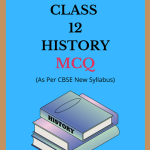NCERT Class 12 History MCQ Chapter 7 An Imperial Capital- Vijayanagara Solutions to each chapter is provided in the list so that you can easily browse through different chapters NCERT Class 12 History MCQ Chapter 7 An Imperial Capital- Vijayanagara and select need one. NCERT Class 12 History MCQ Chapter 7 An Imperial Capital- Vijayanagara Question Answers Download PDF. NCERT History MCQ Class 12 Solutions.
NCERT Class 12 History MCQ Chapter 7 An Imperial Capital- Vijayanagara
Also, you can read the NCERT book online in these sections Solutions by Expert Teachers as per Central Board of Secondary Education (CBSE) Book guidelines. CBSE Class 12 History MCQ Solutions are part of All Subject Solutions. Here we have given NCERT Class 12 History MCQ Part – I: Themes in Indian History, History MCQ Part – II: Themes in Indian History, History MCQ Part – III: Themes in Indian History. NCERT Class 12 History MCQ Chapter 7 An Imperial Capital- Vijayanagara Notes, NCERT Class 12 History MCQ Notes for All Chapters, You can practice these here.
An Imperial Capital- Vijayanagara
Chapter: 7
| THEMES IN INDIAN HISTORY (PART – II) |
| MCQ |
1. Find out the correct one from the following list:
(a) Nayak: Military Commander.
(b) Hiriya: Lake.
(c) Kamalapuram: Canal.
(d) Mandapam: King.
(e) Krishan Dev Rai: Temple Campus.
Ans: (a) Nayak: Military Commander.
2. Where is the famous Virupaksha Temple located?
(a) Srikalahasti.
(b) Hampi.
(c) Chidambaram.
(d) Bhadrachalam.
Ans: (b) Hampi.
3. Who among the following was the founder of the Vijaynagar Kingdom and the city according to the Kapaluru and Begepalli grants?
(a) Saluva Narsimha.
(b) Vir Narsimha.
(c) Tiri mala.
(d) Hari and Bukka.
Ans: (d) Hari and Bukka.
4. Vijayanagara Empire was established most probably in:
(a) 1336.
(b) 1436.
(c) 1536.
(d) 1600.
Ans: (a) 1336.
5. The Aravidu dynasty ruled from:
(a) Chandragiri.
(b) Penukonda.
(c) Vijayanagara.
(d) Tirupati.
Ans: (a) Chandragiri.
6. In India conservation begin under:
(a) Johan Marshal.
(b) Jahan Bosh.
(c) Johan Parker.
(d) Johan Canady.
Ans: (a) Johan.
7. UNESCO declared Hampi a world Heritage site in the year:
(a) 1986.
(b) 1980.
(c) 1880.
(d) 2006.
Ans: (a) 1986.
8. What was the Nayakar system?
(a) In it king appointed high officials from the class of Jagirdars.
(b) King gave some regions for use to commanders for keeping a definite army.
(c) King kept contorl on Nayaks through the Nayankars.
(d) All of them.
Ans: (b) King gave some regions for use to commanders for keeping a definite army.
9. What was the land given to Nayaks called?
(a) Amaram.
(6) Poliagar.
(c) Sist.
(d) None of the above.
Ans: (a) Amaram.
10. Which is not true with reference to Vijaynagara administration?
(a) Though all power lay in the hands of king, yet a cabinet to advise him was in existence.
(b) Provincial rulers were free to a limit. They had their court, army and coins.
(c) There was no region in the entire empire where the subordinate rulers ruled.
(d) The rulers of Vijayanagara maintained the traditions of village administration.
Ans: (a) Though all power lay in the hands of king, yet a cabinet to advise him was in existence.
11. Consider the following statement (s) related to the features of Vijaynagar Empire.
I. It was monarchy.
II. Land tax was an important source of revenue for the empire.
Select the correct statement (s):
(a) Only I.
(b) Only II.
(c) Both I and II.
(d) Neither I nor II.
Ans: (c) Both I and II.
12. Who was responsible for the defeat of Vijayanagar in the Battle of Talikotta in 1565?
(a) Krishna Deva Singh.
(b) Rama Raja.
(c) Harihar II
(d) Devraya I.
Ans: (b) Rama Raja.
13. Which of the following temples is an example of Wall inscriptions on which stories of Ramayana and the Mahabharata are inscribed?
(a) Tadapatri.
(b) Varadraja.
(c) Parvati.
(d) Vithalswami.
Ans: (d) Vithalswami.
14. Hazara Ramasami temple was built under the —-.
(a) Vijayanagar empire.
(b) Bahmani kingdom.
(c) Chola empire.
(d) None of the above.
Ans: (a) Vijayanagar empire.
15. Which goddess is called Pampa?
(a) Saraswati.
(b) Parvati.
(c) Laxmi.
(d) Durga.
Ans: (b) Parvati.

Hi! my Name is Parimal Roy. I have completed my Bachelor’s degree in Philosophy (B.A.) from Silapathar General College. Currently, I am working as an HR Manager at Dev Library. It is a website that provides study materials for students from Class 3 to 12, including SCERT and NCERT notes. It also offers resources for BA, B.Com, B.Sc, and Computer Science, along with postgraduate notes. Besides study materials, the website has novels, eBooks, health and finance articles, biographies, quotes, and more.




